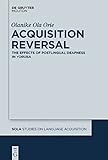Acquisition Reversal : The Effects of Postlingual Deafness in Yoruba / Olanike Ola Orie.
Material type: TextSeries: Studies on Language Acquisition [SOLA] ; 47Publisher: Berlin ; Boston : De Gruyter Mouton, [2012]Copyright date: ©2012Description: 1 online resource (281 p.) : One mapContent type:
TextSeries: Studies on Language Acquisition [SOLA] ; 47Publisher: Berlin ; Boston : De Gruyter Mouton, [2012]Copyright date: ©2012Description: 1 online resource (281 p.) : One mapContent type: - 9781614510437
- 9781614510451
- RF293.4 .O75 2012
- online - DeGruyter
- Issued also in print.
| Item type | Current library | Call number | URL | Status | Notes | Barcode | |
|---|---|---|---|---|---|---|---|
 eBook
eBook
|
Biblioteca "Angelicum" Pont. Univ. S.Tommaso d'Aquino Nuvola online | online - DeGruyter (Browse shelf(Opens below)) | Online access | Not for loan (Accesso limitato) | Accesso per gli utenti autorizzati / Access for authorized users | (dgr)9781614510451 |
Frontmatter -- Contents -- Acknowledgments -- Abbreviations -- Chapter 1. Postlingual Deafness -- Chapter 2. The Yoruba: the people and their language -- Chapter 3. Deafness, Societal Attitude, and Language Adaptation -- Chapter 4. Yoruba Sign Language: A Basic Description -- Chapter 5. Postlingual Deafness at Age 5: Patterns of Loss after 25 Years -- Chapter 6. Postlingual Deafness at Age 8: Patterns of Loss after 25 Years -- Chapter 7. The Connection of Postlingual Deafness Language Loss to Acquisition -- Chapter 8. Summary, Suggestions for Rehabilitation and Further Research -- References -- Index
restricted access online access with authorization star
http://purl.org/coar/access_right/c_16ec
This is the first comprehensive account of prolonged hearing loss and its impact on a language that was once spoken fluently. Although it is currently assumed that hearing loss results in speech deterioration, it is shown that language loss occurs when speakers remain deaf for a long time. The reader is introduced to a significant deaf population - postlingually deafened Yoruba speakers who have been deaf for more than twenty years and who have no access to hearing aids or speech therapy. After becoming deaf, they continue to speak Yoruba from memory and “hear” visually through lip reading. These speakers exhibit phonological, lexical and syntactic losses which mirror acquisition patterns attested in the speech of Yoruba children. Based on these similarities, it is argued that a direct link exists between language loss and first language acquisition. It is further argued that prolonged deafness results in language reversal. Finally, the book presents the first description of the sign language and gestures used by deafened speakers to augment their spoken language. These findings will be of value to linguists, speech, language and hearing therapists, anthropologists, Africanists, deaf studies researchers, and non-specialists who are interested in hearing health and wellness.
Issued also in print.
Mode of access: Internet via World Wide Web.
In English.
Description based on online resource; title from PDF title page (publisher's Web site, viewed 28. Feb 2023)


